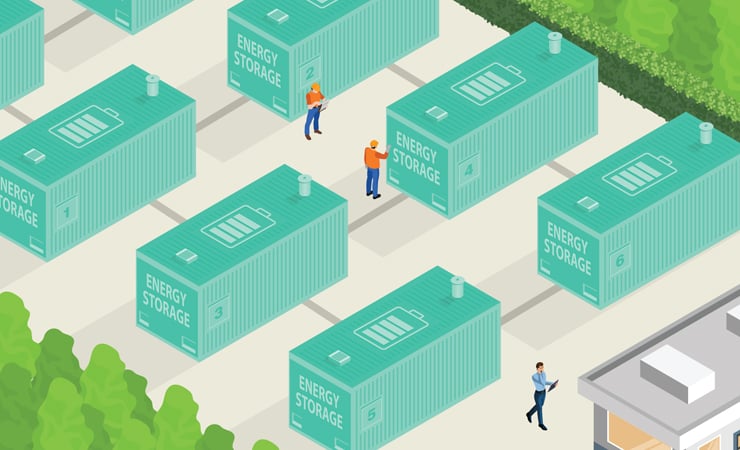
Insurance is a cornerstone of de-risking financing and investment into energy storage. Data
and analytics-driven decision making is not only for the operation and optimisation of batteries, it’s also vital for peace of mind and cementing the long-term success of the industry, Charley Grimston, co-founder of specialist insurer Altelium writes.
This is an extract of an article which appeared in Vol.30 of PV Tech Power, Solar Media’s quarterly technical journal for the downstream solar industry. Every edition includes ‘Storage & Smart Power,’ a dedicated section contributed by the team at Energy-Storage.news.
Enjoy 12 months of exclusive analysis
- Regular insight and analysis of the industry’s biggest developments
- In-depth interviews with the industry’s leading figures
- Annual digital subscription to the PV Tech Power journal
- Discounts on Solar Media’s portfolio of events, in-person and virtual
Insurance has always been a building block of market growth. The possession of insurance or, in the case of lithium-ion battery products, an insured warranty, is a sign that the product is supported, understood, evaluated and assessed against risk.
The warranty will last beyond the life of the original manufacturer and gives the product quality assurance and bankability, enabling the market to grow and mature. It therefore plays a vital role in the devel- opment of the battery energy storage market.
In addition to this role in helping to secure finance, or in taking risk and financial liability off a business’s balance sheet, insurance can play a key part in helping to meet Environmental Social and Governance (ESG) targets. In doing this, it also helps address and overcome some of the key challenges of the sector, namely confidence in battery lifecycles and fire safety risks.
This is because the information and techniques required to secure insurance, such as due diligence of risk and risk mitigation, are also required by new climate change regulations.
The process can also play a meaningful part in establishing best practice procedures relating to site planning, design and operation to mitigate fire risk, particularly in the context of securing Operational All Risk (OAR) insurance for energy storage sites.
The global standard for corporate climate-related financial reporting is the framework of The Task Force on Climate-related Financial Disclosures (TCFD). Endorsed by the G7 and G20, more than 2,200 organisations have officially supported reporting in alignment with the TCFD.
The demand from investors for meaningful information on how companies are preparing for the climate transition is directly relevant to anyone operating in the energy storage market.

Understand risk to reap rewards
In the same way that life cycle analysis of carbon emissions has to be calculated at every stage in the product’s development, from first to end of life to give a realistic calculation of carbon output (or reduction) so too risk has to be understood and quantified at every stage; from understanding manufacturing systems and internal battery chemistry, to knowledge about best practice operating plans and procedures in energy storage systems.
This is why insurers who specialise specifically in batteries are so important to the future of the energy storage market, because few have the ability to understand the chemistry and technology involved, or the ability to process and apply the battery data required to understand, mitigate and price the risk to offer realistically valued premiums and meaningful terms.
While energy storage companies will want to ensure good ESG ratings for their stakeholders, investors and customers, the metrics and processes involved can play an important part in securing insurance, reducing risk, improving operational safety and increasing profitability.
Reviewing design plans, including heating and ventilation, fire detection systems such as gas detection and infrared thermal cameras, plus water management, spacing of units and blast walls, will all be part of good risk mitigation and planning.
Work together with your insurance provider
There is, of course, mutual interest between lenders and borrowers in ensur- ing projects are appropriately protected against relevant risk exposures. The more well designed and operated the storage system, the more favourable the insurance terms will be and it stands to reason, the more sustainable and higher ranking on any ESG framework that asset will perform.
Insurers are the keepers of extensive applied battery knowledge and experience, and by forming a good working relationship and sharing knowledge with them, the energy storage market will benefit from this expertise through improved premiums and services.
There are two layers to the process used by insurers to assess risk. Firstly the reference data of the batteries involved is examined, to understand the battery chemistry and the electrical architecture within the BESS. The second layer is to look at the operational data from the site to understand how the asset has been designed and built and how it is being managed – the system of checks and maintenance in place.
AI and advanced science replaces historical reference points. Altelium for example works with Lancaster and Newcastle Universities in the UK, each specialists in different areas of lithium-ion chemistry, and our co-founder Professor Harry Hoster is Scientific Director of ZBT, Centre for Hydrogen and Fuel Cell Technology at Duisburg-Essen University, Germany.
This is an extract of an article from Volume 30 of PV Tech Power, our quarterly journal. You can buy individual issues digitally or in print, as well as subscribe to get every volume as soon as it comes out. PV Tech Power subscriptions are also included in some packages for our new PV Tech Premium service.
About the Author
Charley Grimston is executive Chairman and co-founder of Altelium, an insurtech business offering insurance for batteries driven by real-time AI-powered data analytics.
He has deep experience of the insurance industry, remembers the excitement of first seeing a US wind turbine in 1976 being underwritten in the Lloyd’s market and has been involved in the green energy industry ever since. Charley is a member of the British Standards Institution (BSI) committee which developed the UK standards for safe and environmentally conscious handling of battery packs and modules.

